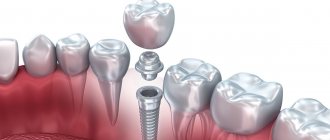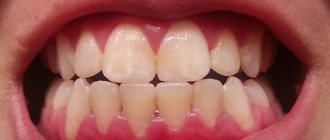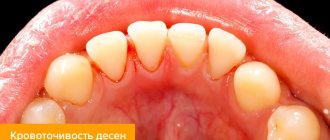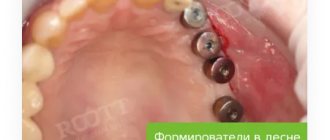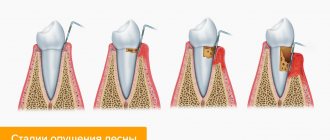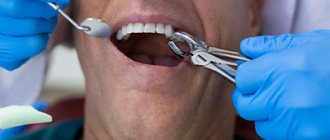Smiles are different. But they are always formed by teeth. With excessive visualization of gum tissue (the upper gum opens at the moment of smiling), a so-called “gum smile” (also known as a “horse smile”) or Gummy Smile. And although this feature often has absolutely no effect on the functionality of the dentofacial apparatus, the owners of such a smile cannot always be envied.
Looking ahead, it is necessary that this is not a pathology, but most likely an aesthetic (visual) defect. However, the presence of such a defect in a person can cause psychological discomfort and develop serious complexes. That is why it is recommended to eliminate a “gummy smile”. If the defect is not severe, and the owner of an unusual smile does not have any malocclusion or complexes, then it is not necessary to resort to any treatment.
Gummy smile: does it require treatment?
Symptoms of a gummy smile – is there a problem?
It is worth noting that a gummy smile in itself is not a pathology , it does not in any way affect the health of the teeth, and does not have a negative impact on the process of chewing and digestion.
But many owners of this feature, most of them women, want to get rid of it, make their face more harmonious, because with such visualization it is sometimes visible, for example, that the teeth are dentures, the color of the gums has changed to bluish, yellowish or purple, the gums are affected by periodontal disease. In this case, we are talking about smile aesthetics , which can be achieved by several types of correction.
Video: Gummy Smile. Correction methods
A person’s gummy smile is immediately noticeable - not only the upper teeth are exposed, but also most of the gums, and in some cases the demarcation line between the gum and lip is visible, as well as the place where the upper frenulum is attached to the gum.
A high smile is indicated by the degree of gum exposure. A relative norm is a smile in which the upper lip remains on the upper line of the teeth - or no more than 2 mm above it.
Fillers and Botox
A gummy smile can be avoided by working on more than just your teeth. If the problem is a short upper lip, and the deficiency is not too pronounced, you can get by with minimally invasive procedures in the chair of a completely different doctor. Such methods began to be practiced relatively recently, but they are quickly gaining popularity in this area.
We are talking about introducing special substances into the upper lip that increase its volume. In this case, it will look plumper and will partially hide the gums when smiling, compensating for the deficiency. It is important not to overdo it, otherwise your face will look unnatural.
If you experience a gummy smile, Botox correction may also help. The fact is that an upper lip that is too mobile can rise too much. Therefore, injections of a special toxin are practiced that paralyzes the muscles in the mouth area. This allows you to reduce mobility and eliminate the defect.
The advantage of these methods is their relatively low cost, painlessness and simplicity. There is no need for a long healing period. Unfortunately, the effect is also short-lived - the procedure will have to be repeated every few months. Botox can even have an undesirable effect in the form of facial asymmetry.
Reasons for the formation of a high gummy smile
In the vast majority of cases, high gums when smiling are the result of individual developmental characteristics of the maxillofacial region of a person, which are formed in utero.
There are a number of other reasons when a person develops a gummy, or “horse” smile:
- Abnormal growth of the maxillofacial apparatus in infancy and childhood under the influence of various negative factors.
- Formation of malocclusion in a child.
- Irregular growth of teeth, their severe curvature and protrusion.
- Very short and thin upper lip.
- Shortening of the upper frenulum that was not corrected in time.
- Disproportionately small incisors on the upper jaw.
- Greater mobility of the upper lip.
- Spastic conditions in this area.
Causes
A horsey, or gummy, smile can be present due to various factors. Firstly, this may simply be a structural feature of the upper jaw or an anomaly of the entire facial skeleton. In this case, there is a lengthening of the entire middle part of the face and a special arrangement of the teeth. Secondly, there is the concept of hyperplasia, that is, the growth of gums. Thirdly, the cause of the deficiency may simply be a shortened upper lip or its hypermobility due to increased activity of the orbicularis oris muscle. Finally, another cause may be an incorrect bite.
At the same time, a gummy smile of varying degrees of severity is observed in approximately 15% of people around the world, including very well-known ones.
Gingivectomy is a dental or surgical method for correcting high gums.
The gingivectomy method is indicated for conditions where there is too much gum above the upper teeth. As a result, it covers a very large part of the teeth, as if hanging over them, which forms a visual gummy smile.
Types of osteomucogingival surgeries in dentistry
It must be borne in mind that the results of this method are irreversible, so surgical correction is prescribed in the most extreme cases with the above-described features, and this happens infrequently.
Video: Gingivectomy - treatment of a gummy smile
The operating method is the most difficult. It is associated with the removal of gum tissue, which invariably has all the consequences of surgical intervention - bleeding of the gums, scarring, possible infection, asymmetry. The development of laser surgery helps to minimize the above-described consequences in operative dentistry, but it is still necessary to keep them in mind, paying due attention to preventive measures.
Removing gum tissue can lead to another consequence that has aesthetic and dental significance - excessive exposure of teeth. This will visually lengthen the teeth and partially expose the roots, which will negatively affect subsequent aesthetics. Therefore, further orthodontic correction with the use of dental crowns and onlays is required.
In order to get the most successful results, the dentist will make a decision not alone, but with a council of specialists, which should include a specialist in aesthetic dentistry.
A decision is made collectively about the need for surgery, and the volume of gum tissue that will be removed without negative consequences for aesthetics is determined as accurately as possible.
How to fix a gummy smile
Aesthetic dentistry uses surgical, orthodontic, orthopedic, cosmetic and even speech therapy correction methods. The degree of patient involvement depends on the method. In surgical cases, it is minimal, the effect is lasting, the patient is only required to follow the usual recommendations. Installing braces requires more discipline and involvement, and speech therapy exercises depend almost entirely on the patient’s responsibility and constant monitoring of articulation.
Surgical intervention
- Gum plastic surgery
for a gummy smile (gingivoplasty) is the most common correction method.
It is considered a simple operation and does not require going to the hospital. Takes a maximum of 2 hours, often less.
A dental surgeon performs an operation to remove excess tissue (gingivectomy) and shape the contour of the gums. The mucous membrane is lifted to make a larger area of the crown part of the tooth visible, and excess tissue is removed. Surgery to correct a gummy smile is minimally invasive and is done using a laser beam. It immediately seals the vessels, preventing bleeding. There are no stitches, so the recovery period takes little time. In addition, the laser destroys pathogenic flora; there are practically no complications after such operations.
The only thing worth remembering is that if you remove too much tissue, it will lead to the opposite aesthetic effect - long teeth. A special technology helps to avoid this result: “digital smile design.” Thanks to it, the result of the intervention can be seen even before the operation and it is possible to determine exactly how much tissue needs to be removed.
- Frenum cutting (frenuloplasty)
Another simple operation that improves not only the aesthetics of a smile, but also diction. The fact is that the lips are actively involved in articulation. A short lip cannot do this 100%, which affects the pronunciation of individual sounds and makes speech unclear and blurred. Additionally, people with a short frenulum tend to breathe through their mouths. This dries out the mucous membrane, creating conditions for colds and inflammatory processes in the nasopharynx. Frenuloplasty eliminates these problems by promoting clear articulation, correct breathing patterns, and at the same time making the smile more attractive. Typically, this procedure is performed in childhood, but some adults also experience a shortened frenulum.
- Suturing the orbicularis oris muscle
A minor surgical intervention reduces the tone of the muscle, and it stops lifting the lip too much. You can get rid of a gummy smile in less than an hour.
Orthodontic treatment
If you have problems with your bite, braces or aligners can help correct the position of your jaws. Some malocclusions cause the upper teeth to move out of the jaw, and the gums attached to them also move downward. Treatment with braces or mouthguards brings the teeth back, and with them the gums.
With severe pathology of the maxilla, orthognathic surgery is necessary. It is performed by a gnathologist or maxillofacial surgeon under general anesthesia. Some bone is removed to recreate symmetry between the upper and lower jaw. As a result, the height of the upper jaw decreases, the mucous membrane is not exposed excessively.
Orthopedic intervention
To visually lengthen teeth in case of pathological wear, for example, an orthodontist installs veneers or crowns. Veneers build up teeth by no more than 1-2 mm; if you need to build up more, artificial crowns are used.
Correction of a high smile using a cosmetic method using Botox
In case of hypermobility of the upper lip, excessive facial expressions of the patient, when they cause the visualization of the gums when smiling and talking, there is an excellent method for correcting the condition - Botox injections, which relax the active muscles of this area and help reduce their mobility.
Treatment is achieved by administering bolutoxin type A (Botox and Dysport, popular drugs in cosmetology).
Video: Correction of a gummy smile with Botox
Women who receive Botox injections in cosmetology clinics to reduce wrinkles on the face and enlarge lips also note correction of a gummy smile, if present.
This method, unlike the surgical one, is reversible - this is both a minus and a plus at the same time. Up to six months, the effect of the injections wears off, and so does all the correction he achieved. The procedure must be repeated if desired.
It is very important to entrust the injection Botox correction of a gummy smile to an aesthetic dentistry clinic, a specialist with extensive experience and relevant medical knowledge.
Attention! The consequences of incorrect administration of Botox can be asymmetry of the face and lips, with an incorrectly calculated dose - lack of results, or vice versa - a strong degree of immobilization of the perioral area.
Symptoms and diagnosis
Gum smile is easy to diagnose. The dentist is able to detect the deficiency already during the initial visit. If you look at the teeth in a gummy smile, you can immediately see the problem. Sometimes the upper teeth protrude forward. This leads to the fact that the lips cannot close completely when at rest.
In addition to visual defects, a patient with a gummy smile may have additional symptoms:
- Increased gum bleeding and systematic inflammation. They occur with soft tissue hyperplasia and excessive gum growth.
- Hyperfunction of facial muscles. There is increased tension in certain areas of the face and lips.
- Volumetric lower face. Occurs due to the growth of the upper jaw.
- Changing the direction of the upper incisors. They may move towards the mouth or tongue.
For diagnosis, a visual inspection is performed. To clarify the diagnosis, photographs and casts, as well as modeling, may be required.
Speech therapy correction of a gummy smile
The method is indicated for insignificant visualization of the gums, or for excessive facial expressions of the patient, hypermobility of the lips.
The correction process is carried out with a speech therapist who teaches a person to correctly pronounce sounds and words, control his speech apparatus while talking or smiling.
Excellent results are achieved by performing certain exercises regularly. In the future, the person simply automatically controls the movement of his lips, stopping the upper lip in the correct position, which allows him to achieve an excellent aesthetic effect without any intervention in the tissue.
The method of speech therapy correction perfectly complements other methods from our list. It is suitable for most people who want to correct a high type of smile.
Keep in mind! But without constant self-control and regular exercise, you may not get results.
Cost of smile correction
The cost of correction depends on how the correction is performed. The cost is variable and depends on the region of residence of the patient. In the periphery, such a service is cheaper, but practice shows that more professional and experienced specialists can be found in Moscow, the region and St. Petersburg.
- Orthodontic treatment costs 30 thousand rubles or more. Depends on the material from which the correction systems are made and its service life.
- Surgical intervention costs at least 50–70 thousand rubles. The more experienced the specialist, the more expensive his work.
- Cosmetic correction is the most budget-friendly of all options. Injections cost 10–20 thousand rubles.
Surgical correction of the upper lip and upper frenulum
The surgical method consists of excision of a section of the mucous membrane on the inner surface of the upper lip and further attachment of the muscle fibers of the lip slightly lower than their original state.
If the cause of excessive visualization of the gums - and errors in eating and speaking - is a greatly shortened upper frenulum, which forms a dense cord and does not allow the upper lip to be lowered to the desired level, it is corrected.
As a rule, such an operation on the frenulum is performed in childhood.
After the surgical field has healed, the desired visual effect is achieved.
Gummy smile treatment: crown lengthening and lip repositioning
A smile in which the gums are exposed by more than 3 mm is in most cases considered by patients as an aesthetic disorder that requires appropriate dental correction. For such aesthetic rehabilitation, a comprehensive interdisciplinary approach to treatment is mandatory, since adjusting the contour and volume of the gums is a very delicate surgical procedure that requires mandatory follow-up.
To restore an adequate smile design, standard ratios of the geometric parameters of teeth are often used, taking into account the dynamics of their changes depending on age, gender and individual aspects. In addition, it is important that the future appearance of the patient’s smile satisfies not only the attending physician, but also the patient himself, therefore dialogue between the parties is an essential component of complex treatment.
Lengthening the clinical crown involves removing a certain amount of hard and soft periodontal tissue to expose the required visual height of the tooth, taking into account the parameters of the biological width. If the level of crystalline bone is high, the doctor may need to reduce its vertical parameters in order to expose the structure of the anatomical crown. At the same time, to achieve a more aesthetic appearance of the gums, the vestibular fragment of bone tissue is prepared, thus achieving the most aesthetic treatment result. Lip repositioning involves removing a strip of non-keratinized mucosa from the vestibule area of the oral cavity. After this, the mucous membrane of the lip is sutured to the mucogingival border, which helps to reduce the size of the vestibule of the oral cavity. In this way, it is also possible to limit the muscle tension parameters, which reduces the range of gum exposure during smiling.
This article describes a clinical case in which clinical crown lengthening and lip repositioning procedures were used to correct a gummy smile in an older patient.
Clinical case
A 58-year-old female patient presented to the dentist with the chief complaint of excessive gingival exposure when smiling (Figure 1).
Photo 1. Gummy appearance of the smile before treatment.
The maxillary teeth were visualized as too short, surrounded by thick soft tissue biotype. The height of the alveolar ridge was quite high, which caused the gums to appear too convex in relation to the short teeth (photo 2).
Photo 2. Visualization of the features of the bone relief and proportionally short crowns.
After anesthesia with 2% lidocaine with 1:100,000 epinephrine, the first incision was made on the labial side of teeth 2 to 15 using a #15 Bard-Parker blade. The direction of the incision imitated the contours and position of the cemento-enamel interface of the teeth, after which the excess amount of gingival tissue was removed (photo 3).
Photo 3. Gingivectomy to expose crowns to anatomical parameters.
After separation of the full flaps, the level of the crestal bone was visualized, which in some places was above the level of the cemento-enamel junction (photo 4).
Figure 4. Separation of the gingival flap helped to visualize the high position of the marginal edge of the bone crest.
On the vestibular side of the teeth, the marginal edge of the bone tissue was contoured approximately 3 mm from the level of the cemento-enamel junction using round carbide burs. In addition, the alveolar bone on the vestibular side was thinned to mimic a more natural soft tissue architecture (Figure 5).
Photo 5. Contouring of the bone crest level.
To maintain the tissues of the interdental papillae, the bone tissue in these areas was left almost intact. The surgical site was closed using a running suture using 4.0 chrome catgut (Ethicon) (Figure 6).
Photo 6. Suturing the gingival flap using chrome-plated catgut sutures 4.0.
The patient was prescribed ibuprofen 600 mg and amoxicillin 875 mg twice daily for 10 days, and 0.12% chlorhexidine gluconate mouth rinse at similar frequencies (Peridex, 3M) for 1 week. Sutures were removed 1 week after treatment, and 12 weeks after treatment, the problem area showed excellent signs of healing without any symptoms of inflammation (Figure 7).
Photo 7: View after 12 weeks: more attractive profile of pink and white aesthetics.
Subjectively, the patient was satisfied with the new contour of the gums and was ready for the next stage of treatment - repositioning the upper lip. After deep anesthesia with 2% lidocaine with 1:100,000 epinephrine, a sterile surgical marker was used to outline the strip of mucosa to be removed (Figure 8) between the maxillary molars (the strip was approximately 8 mm wide).
Photo 8. Marking a strip of mucosa for further removal.
The epithelial layer of mucosa was removed using a #15 blade (Figure 9), and the wound was sutured with VICRYL 4.0 (Ethicon) (Figure 10).
Photo 9. Removal of the mucosal strip.
Photo 10. Suturing the wound using VICRYL 4.0 threads.
The patient was prescribed maintenance drug therapy similar to that prescribed after the first intervention. The sutures were removed 2 weeks after the procedure, and after 8 weeks the surgical site showed excellent signs of healing (Figure 11). As the patient smiled, the range of gingival exposure was significantly reduced, which in turn reduced the visual volume of the gummy smile. In addition, the appearance of the upper lip after surgery was fuller and more attractive (Figure 12).
Photo 11. Healing of the intervention area after 8 weeks.
Photo 12. The patient’s attractive smile after lengthening the crowns of the teeth and repositioning the upper lip.
Discussion
There are several reasons for the formation of a gummy smile: this is gum hyperplasia, and a violation of passive eruption, and excessive vertical parameters of the upper jaw, and hypermobility of the upper lip, which can be combined with its too short shape. Tjan et al, in a study of 450 patients aged 20 to 30 years, found that gummy smiles were observed in 7% of men and 14% of women.
In this clinical case, the patient with a gummy smile had a thick gingival biotype, as well as a high position of the marginal edge of the alveolar ridge, which was reminiscent of the clinical case described by Kois in 1994. To correct the smile, clinical lengthening of the crown was performed to its anatomical parameters (cemento-enamel level). boundaries).
To obtain an adequate architecture of the gums and adapt the parameters of the biological width, the level of the bone tissue was contoured, and in some areas reduced on the vestibular side to form a more adequate appearance of the soft tissues, which during the initial examination looked somewhat convex.
As a result, after 12 months it was possible to achieve an adequate appearance of the smile regarding the formation of aesthetically acceptable proportions of the teeth and the profile of the soft tissues. To reduce the range of gingival exposure, a repositioning procedure of the upper lip was also performed by excising the desired amount of mucosa approximately 8 mm wide. The wound was closed with single sutures to ensure stable healing of the edges.
The procedure of gum repositioning during the correction of a gummy smile was first described in 1973 by Rubinstein and Kostianovsky. In 1983, the procedure was modified slightly to include muscle resection and nerve repositioning, which provided better consistency of surgical results. In 2006 and 2007, it was proposed to use an elliptical flap design during the procedure, which was used in this clinical case. Lip repositioning, in its essence, is a safe procedure, which, as a rule, does not provoke additional complications. The method was developed as a less invasive alternative to orthognathic surgery for smile profile correction. After the intervention, the patient may experience slight bruising and swelling of the upper lip, which, in turn, may cause some postoperative discomfort.
Rosenblatt and Simon even reported a case of mucocele formation after lip repositioning, which subsequently resolved spontaneously. Silva et al reported high levels of patient satisfaction 2.5 years after the procedure, with 70% of patients feeling that the postoperative level of gingival exposure was quite adequate, and 90% of patients would have the procedure done again if warranted. Confirmation of the stability of the results of lip reposition requires, however, longer-term monitoring, which could confirm the effectiveness of this minimally invasive technique. In addition, instead of the term “lip reposition”, the term “lip stabilization” can be used, since during the procedure the doctor limits the mobility of the lip when smiling, that is, stabilizes it in a more aesthetic position. Moreover, patients perceive the term lip stabilization more adequately than reposition.
conclusions
A combination of clinical crown lengthening and lip repositioning techniques is an effective approach to reduce the range of gingival profile exposure while correcting the aesthetic appearance of a gummy smile.
Author: Douglas H. Mahn, DDS
Orthodontic correction of high smile and dental problems
If a gummy type of smile is the result of improper formation of the dentition, deformation of not only the teeth, but also the bone tissue of the jaws, the help of an orthodontist is required.
This method may include several types of orthodontic correction, depending on the type and degree of pathology, the age of the patient, and the presence of other pathological conditions.
Most often, orthodontic correction consists of straightening the teeth through long-term wearing of braces.
In most cases, this correction method is used in combination with others - for example, surgical or cosmetic.
Dentistry
There are still some options that your doctor may suggest if you experience a deficiency such as a gummy smile. Correction can be carried out using frenuloplasty, that is, excision of the frenulum of the upper lip. Another option is correction of the gingival margin. In the latter case, using a laser, the doctor removes excess tissue and forms a new contour. This method can also be combined with prosthetics - the use of veneers and crowns, if the problem is also the unsightly shape of the teeth. This correction of a gummy smile does not require additional supportive procedures and has a lifelong effect.
If the problem is a malocclusion, an orthodontist will help. Fortunately, even quite serious problems can be corrected with the help of braces and braces. Of course, this is more effective in adolescence, but it works for adults too. The disadvantage of this method is that not everyone wants to wear braces on their teeth for a long time, and they are also difficult to care for. But the beauty is probably worth it.
Postoperative care
Postoperative oral care plays an important role in the treatment and recovery of dental deficiencies. To alleviate the condition during rehabilitation and protect yourself from the development of serious complications, you must follow the following rules:
- Avoid temperature and chemical irritants (hot, sour, spicy).
- Stop drinking alcoholic beverages and tobacco products.
- Carry out antiseptic and anti-inflammatory oral baths daily with a solution of chamomile and miramistin.
- Perform hygiene procedures 2 times a day using a soft toothbrush and medicated paste.
If your health worsens or suspicious discharge from the gum tissue appears, you should immediately consult your doctor.
When purulent exudate forms, the dentist-surgeon removes discharge from the gum pockets using special instruments, after which he prescribes antibacterial therapy.
